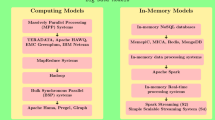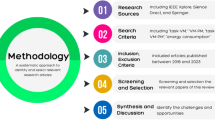Abstract
Virtual worlds are both computation and communication intensive as they provide rich content and frequent updates to players for an improved performance. Virtual worlds use spatial partitioning to scale and dynamic scalability frameworks are the preferred choice for an improved resource utilisation. However, they are very costly in terms of time, as the re-allocation process involves transferring both content and players. Similarly, for an improved interactive experience, users are sent to transit region during a transfer. However, it adds a huge amount of time when an increasing number of users are transferred in sequence. This paper introduces the methods used for players’ movement in OpenSimulator framework with an emphasis on teleport mechanism. It investigates the impact of sequential transfer of increasing number of players on content transfer during the re-allocation process before developing a parallel alternative. The proposed method utilises multi-core processors to transfer players, using the teleport method, in a re-locating region, which is compared with the sequential method adopted earlier for implementing scalability in OpenSimulator. Two different implementations of the parallel algorithm one using, parallel for, and the other utilising, chunk partitioning, are used for comparison with the sequential approach. It is demonstrated that both the parallel implementations improved over the sequential approach in terms of time. Chunk partitioning, however, obtained the best result for the current configurations. Overall, huge reductions in time were observed in the re-allocation process using the improved mechanisms. However, additional and dedicated resources are expected to further improve the timings required for players’ transfer and re-allocation process.



Similar content being viewed by others
References
Abdulazeez SA, El Rhalibi A (2018) Dynamic load balancing for massively multiplayer online games using opnet. In: International conference on E-learning and games. Springer, pp 177–191
Alahuhta P, Nordbäck E, Sivunen A, Surakka T (2014) Fostering team creativity in virtual worlds. Journal For Virtual Worlds Research, 7(3). https://journals.tdl.org/jvwr/index.php/jvwr/article/view/7062
An Y (2019) Creating smart learning environments with virtual worlds. In: Foundations and trends in smart learning. Springer, pp 89–92
Artis C Alfea 3 - OpenSim Archive (OAR). http://www.outworldz.com/Sculpts/cgi/files/OAR-alfea3.zip/ Last accessed: April, 2021
Balan RK, Ebling M, Castro P, Misra A (2005) Matrix: Adaptive middleware for distributed multiplayer games. In: Lecture notes in computer science, vol 3790/2005. Springer, Berlin/Heidelberg, pp 390–400
Behnke L (2020) Increasing the Supported Number of Participants in Distributed Virtual Environments. Ph.D. dissertation, School of Computing Sciences - University of the West of Scotland, West Scotland, UK,
Chan L, Yong J, Bai J, Leong B, Tan R (2007) Hydra: A massively-multiplayer peer-to-peer architecture for the game developer. In: Proceedings of the 6th ACM SIGCOMM workshop on network and system support for games. NetGames ’07. Available: https://doi.org/10.1145/1326257.1326264https://doi.org/10.1145/ https://doi.org/10.1145/1326257.13262641326257.1326264. ACM, New York, pp 37–42
Chang F, Bowman CM, Feng W (2010) XPU: A Distributed Architecture for Metaverses. Department of Computer Science, Portland State University, Portland, Oregon, Tech. Rep. 10-04,
Dai Z, Ke F, Dai C-P, Pachman M, Yuan X (2021) Role-play in virtual reality: A teaching training design case using opensimulator. In: Designing, deploying, and evaluating virtual and augmented reality in education. IGI Global, pp 143–163
Elfizar, Baba M S, Herawan T (2019) 1p1o: A large scale distributed virtual environment. In: Abawajy J H, Othman M, Ghazali R, Deris M M, Mahdin H, Herawan T (eds) Proceedings of the international conference on data engineering 2015 (DaEng-2015) . Springer, Singapore, pp 21–29
Elfizar, Baba M S, Herawan T (2019) Object-based simulators for large scale distributed virtual environment. In: Abawajy J H, Othman M, Ghazali R, Deris M M, Mahdin H, Herawan T (eds) Proceedings of the international conference on data engineering 2015 (DaEng-2015) . Springer, Singapore, pp 11–19
Farlow S M (2018) Heuristics for Client Assignment and Load Balancing Problems in Online Games. Ph.D. dissertation, School of Electrical Engineering and Computer Science - Louisiana State University, Louisiana, USA. [Online]. Available: {https://digitalcommons.lsu.edu/gradschool_dissertations/4655}
Farooq U, Glauert J (2011) Scalable virtual worlds: An extension to the OpenSim architecture. In: ICCNIT ’11: Proceedings of the IEEE international conference on computer networks and information technology, pp 29–34
Farooq U, Glauert J (2017) Faster dynamic spatial partitioning in opensimulator. Virtual Reality 21(4):193–202
Farooq U, Glauert J (2017) Integrating dynamic scalability into the opensimulator framework. Simul Model Pract Theory 72:118–130
Farooq U, Glauert J, Zia K (2017) Load balancing for virtual worlds by splitting and merging spatial regions. Informatica, 42(1)
Farooq U, Rabbi I, Zia K, Israr S Z, Shereen M (2018) Quicker re-allocation of regions in opensimulator framework. In: Proceedings of the 2nd international conference on future networks and distributed systems. ICFNDS ’18. [Online]. Available: https://doi.org/10.1145/3231053.3231056https://doi.org/10.1145/ https://doi.org/10.1145/3231053.32310563231053.3231056. ACM, New York, NY, USA, pp 3:1–3:7
González J, Boronat F, Sapena A, Pastor J (2021) Key technologies for networked virtual environments: A new taxonomy. arXiv preprint arXiv:2102.09847
Hakonen M, Bosch-Sijtsema P (2014) Virtual worlds enabling distributed collaboration. Journal For Virtual Worlds Research, 7(3). [Online]. Available: https://journals.tdl.org/jvwr/index.php/jvwr/article/view/6158
Harris DM, Harris SL (2013) Digital design and computer architecture. Elseveir Inc.
Hillar G A C (2010) Professional parallel programming with c#: master parallel extensions with. net 4, John Wiley & Sons
Intel Research Labs. (2010) ScienceSim: A Virtual Environment for Collaborative Visualization and Experimentation. White paper, Intel Labs
Keller J, Laurent M (2017) Divereal: A social virtual world without rooms. In: 2017 15th annual workshop on network and systems support for games (NetGames), pp 1–3
Kim J-H (2020) A hybrid cloud-p2p architecture for scalable massively multiplayer online games. The Journal of The Institute of Internet, Broadcasting and Communication 20(3):73–81
Lake D, Bowman M, Liu H (2010) Distributed scene graph to enable thousands of interacting users in a virtual environment. In: 2010 9th annual workshop on network and systems support for games, pp 1–6
Linden Lab, Inc., Second Life: The Official Website. https://secondlife.com/ Last accessed: April, 2021
Malaby T M (2009) Making virtual worlds: Linden lab and second life, First. Cornell University Press, Ithaca, United States
osgrid.org Inc. OSGRID - The Open Source Metaverse. http://www.osgrid.org, Last accessed: April, 2021
OSim-Wiki OpenSimulator: An introduction. http://opensimulator.org/wiki/Main_Page, Last accessed: April, 2021
OSim-Wiki Teleport agent methods. http://opensimulator.org/wiki/OsTeleportAgent, Last accessed: January, 2021
OSim-Wiki Teleports and teleport protocol. http://opensimulator.org/wiki/Teleport_Protocol, Last accessed: April, 2021
Petrović V M (2018) Artificial intelligence and virtual worlds – toward human-level ai agents. IEEE Access 6:39976–39988
Prasetya K, Wu Z D (2008) Performance analysis of game world partitioning methods for multiplayer mobile gaming. In: Proceedings of the 7th ACM SIGCOMM workshop on network and system support for games. NetGames ’08. ACM, New York, NY, USA, pp 72–77
Prendinger H, Jain R, Imbert T, Oliveira J , Li R, Madruga M (2018) Evaluation of 2d and 3d interest management techniques in the distributed virtual environment DiVE. Virtual Reality 22(3):263–280
Ringler R (2014) C# multithreaded and parallel programming. Packt Publishing Ltd
Rogers T (2013) Should you host on the Amazon cloud?. http://www.hypergridbusiness.com/2013/11/should-you-host-on-the-amazon-cloud/, Last accessed: April, 2021
Spieldenner T, Byelozyorov S, Guldner M, Slusallek P (2018) Fives: An aspect-oriented approach for shared virtual environments in the web. Vis Comput 34(9):1269–1282
Wang T, Wang C-L, Lau FC (2006) An Architecture to Support Scalable Distributed Virtual Environment Systems on Grid. J Supercomput 36 (3):249–264. [Online]. Available: https://doi.org/10.1007/s11227-006-8296-zhttps://doi.org/10.1007/s11227- https://doi.org/10.1007/s11227-006-8296-z006-8296-z
Yilmaz L, Taylor SJE, Fujimoto R, Darema F (2014) Panel: The future of research in modeling and simulation. In: Simulation conference (WSC), 2014 Winter, pp 2797–2811
Yoginath SB, Perumalla KS (July 2015) Efficient parallel discrete event simulation on cloud/virtual machine platforms. ACM Trans Model Comput Simul 26 (1):5:1–5:26. [Online]. Available: https://doi.org/10.1145/2746232
Author information
Authors and Affiliations
Corresponding author
Additional information
Publisher’s note
Springer Nature remains neutral with regard to jurisdictional claims in published maps and institutional affiliations.
Rights and permissions
About this article
Cite this article
Farooq, U., Shereen, M., Zia, K. et al. Reducing the impact of players’ transfer in managing scalable virtual worlds. Multimed Tools Appl 81, 29423–29442 (2022). https://doi.org/10.1007/s11042-022-12505-y
Received:
Revised:
Accepted:
Published:
Issue Date:
DOI: https://doi.org/10.1007/s11042-022-12505-y




